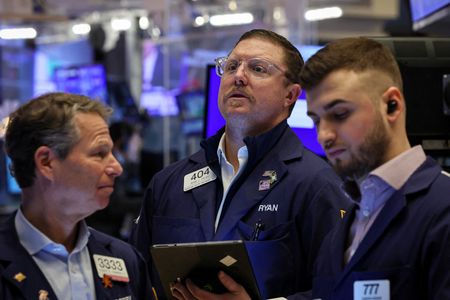By Chuck Mikolajczak and Noel Randewich
NEW YORK (Reuters) -The S&P 500 and Nasdaq closed at record highs on Thursday, buoyed by tech stocks linked to AI, while inflation data and comments from Federal Reserve officials helped shape expectations for the timing of the central bank’s interest rate cuts.
Heavyweight chipmaker Nvidia advanced 2.08% as one of the biggest boosts to the benchmark S&P index and Nasdaq while smaller rival Advanced Micro Devices surged 9.06%. Those and other technology companies have been the centerpiece of a Wall Street rally in recent months, fueled by optimism over growth prospects related to artificial intelligence.
Dell Technologies, which sells AI-optimized servers made with Nvidia’s high-end processors, rose 1.51% ahead of its report after the bell.
Traders added to bets the Fed will cut rates in June, according to CME’s FedWatch Tool, after a Commerce Department report showed U.S. prices picked up in January in line with expectations amid strong gains in the costs of services, while annual inflation was the lowest in three years.
“Without kind of a hawkish surprise here, which it wasn’t, it was soft or at least in line, then there’s no real reason for the market to expect the Fed to get more hawkish than they already outlined,” said Ross Mayfield, investment strategy analyst at Baird in Louisville, Kentucky.
“It doesn’t matter what you think they should do. It’s what they say they’re going to do and once again, the market has been wrestled back into line to where the Fed said they’d be.”
The Dow Jones Industrial Average rose 47.37 points, or 0.12%, to 38,996.39. The S&P 500 gained 26.51 points, or 0.52%, to 5,096.27 and the Nasdaq Composite advanced 144.18 points, or 0.90%, to 16,091.92.
The Nasdaq closed above its prior record high of 16,057.44 set on Nov. 21, 2021, while the S&P bested its closing record of 5,088.80 set just last week.
For the month, the S&P 500 gained 5.17%, the Nasdaq jumped 6.12 pct, and the Dow climbed 2.22%. Each of the three major indexes registered a gain for February, their fourth straight monthly advance. The Russell 2000 Small Cap index rose 5.45% for the month.
Atlanta Fed President and voting member Raphael Bostic stressed taking data-dependent approach to monetary policy, saying it was going to be a bumpy path to the Fed’s 2% inflation target, and repeated his view that he sees the central bank cutting rates “in the summer months.”
Chicago Federal Reserve Bank President Austan Goolsbee said improvements last year in the supply of goods and the labor market paved the way for inflation declines this year, indicating he remains supportive of rate cuts later this year.
Reports on consumer and producer prices earlier in February, which pointed to stubborn inflation, had led investors to dial back expectations of rate cuts to June. At the beginning of this year, traders viewed March as the likely starting point for the Fed’s easing cycle.
Meanwhile, initial jobless claims for the week ended Feb. 24 stood at 215,000, greater than expectations of 210,000, economists polled by Reuters said.
Gains on the Dow were held in check, partly by a 1.59% fall in Boeing after a report of a probe by the Department of Justice.
Snowflake slumped 18.14% after the cloud data analytics company forecast first-quarter product revenue below Wall Street estimates and said CEO Frank Slootman was retiring.
Advancing issues outnumbered decliners by a 2.7-to-1 ratio on the NYSE while on the Nasdaq, advancing issues outnumbered decliners by about a 1.57-to-1 ratio.
The S&P 500 posted 65 new 52-week highs and one new low and the Nasdaq recorded 267 new highs and 82 new lows.
Volume on U.S. exchanges was 13.88 billion shares, compared with the 11.78 billion average for the full session over the last 20 trading days.
(Editing by Richard Chang)

